
^ Back to Home Page ^
Period Roadtests
o

Original test by Bob Currie for The Motorcycle
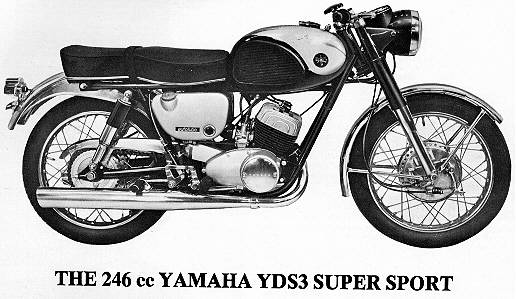
 |
YOWL is almost a trademark of the Scott. Now a newcomer to the British market is poaching, for it is hard to think of any word to describe more accurately the mating call of Yamaha's new YDS3. It yowls and it wails as it goes through its five gears in a fashion to delight the most phlegmatic of riders. On sporty acceleration it sounds every bit as would a four-cylinder racer speeding down the Glencrutchery Road on the TT course. As sporty as they come and as fast. The YDS3 is a marvellous machine to ride. The twin-cylinder power unit does its job with ultra smoothness; only a very slight tingle through the tank at high revs indicates that below lies a high-performance engine. |
| This particular engine, too, is one of the most interesting additions to the scene for many years. Basically it is similar to that of Yamaha's obsolete YDS2 but the big change is the fitting of a small, but all-important, new component, the Autolube pump.
Driven from the gear box, the pump draws its oil from a tank on the offside. It meters the lubricant according to the dictates of engine revs and throttle opening.
Large openings and high revs mean more oil, while for about-town trickling on a wisp of throttle the oil supply is at its minimum.
From the pump the lubricant is carried through a couple of plastic tubes and injected into the induction tracts of the two Mikuni carburettors.
Is Autolube more economical? After 1,300 miles on the YDS3 the answer must be an unequivocal yes. In spite of the fact that for the first 800 running-in miles the pump was set to deliver extra oil, the overall consumption was 1/5th of a pint for every gallon of petrol used an overall ratio of 40 to 1. A normal two-stroke on 20-to-1 mixture would therefore have used twice as much oil.
Thirsty performance However, this impressive oil consumption record is allied with a rather depressing mpg rating. The figures in the performance box were taken at constant speeds in top gear. Use of the searing acceleration had a noticeably adverse effect. Over the 500 or so miles after running-in 45 mpg would be a more representative all-round figure; this, of course, includes some high-speed motorway cruising. It is common knowledge that two-stroke twins are thirsty and for the superlative performance of the Yamaha you must be prepared to put up with a correspondingly high consumption. One point in its favour on this score is that it runs happily on regular grade petrol. It prefers two-stroke oil, but doesn't |
| object to the occasional dose of SAE 30. Yet every penny spent on fuel returns a dividend in performance far beyond all expectations. Under 17s for the standing quarter mile and a set of intermediate acceleration figures to match brand this Japanese sportster as a machine out of the common run; a piece of very hot ginger in the world of two-strokes. Below 2,500 rpm there is little power. That is why the top-gear, 20-to-40 mph acceleration time was not attempted even from 30 to 50 was cruel in a gear that is intended primarily as an overdrive. But above two-and-a-half the power comes, gently at first, but building up until 6,000 appears on that neat revmeter dial. For peak performance this is the bracket in which to keep the needle. There is no objection to such treatment the Yamaha will cruise eedlessly on the motorway at 6,500 rpm, representing approximately 60 mph in fourth and 75 mph in top. | 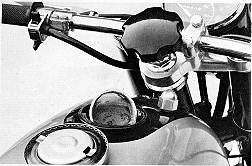
Filler orifice gauze is for filtering fuel, not assisting petrol mixing since Autolube oil injection is by this date provided. |
| More is on tap for overtaking, although top gear meets its match when strong headwinds or hills are encountered.
Fourth gear can be peaked almost any time and that means a speed of close on 80 mph. However, since it represents an engine speed of 8,500 rpm 1,000 rpm above peak power it is not for cruising!
This ability to buzz well above the manufacturer's claim of 27 bhp at 7,500 rpm is a feature. In second gear, especially, the engine will shoot past 10,000 into the red danger area if an eye isn't kept on the dial.
Tacho usefulness That is why the 7'/~-thousand figure was used as an arbitrary maximum in the three lower gears there should be no need to go higher and it as well not to do so regularly. The YDS3 achieves what some manufacturers might consider impossible in a two-fifty it looks sporty and is very sporty, yet it is extremely comfortable and luxurious. The long seat copes with a big pillion passenger in comfort and the fully adjustable controls can be set to suit any rider. On the longest journeys the machine is a joy to pilot. An extremely light and smooth clutch makes gear changing a pleasure, though the box is inclined to be a bit clonky. Probably this stems from the arrangement of having an engine-speed clutch revolving 3'/~ times faster than would be the case if it were mounted on the gear-box mainshaft in the orthodox manner. Bitey behaviour
|
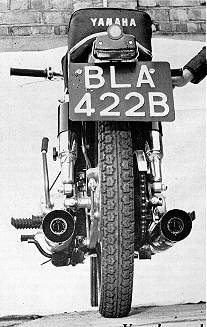
Well snugged-in silencers and centre stand, rightside secondary drive and sturdy spindle draw bolts. |
bounciness sometimes associated with Japanese bikes. They combine the necessary firmness with just the right amount of give to iron out all but the most teeth-shattering of bumps. The Yokohama tyres are an improvement on previous Japanese efforts and no marked tendency to skittishness on wet surfaces is noticeable. In fact, on snow and ice the YDS3 proved very sure-wheeled. Under all conditions the brakes performed admirably. They are at their best at high speeds and are even better than the 34ft braking distance from 30 mph would indicate. Rain, snow, ice the test machine had the lot. It proved its stuff one morning after a night in the open. It was covered by a good '/sin of hoar frost and the ignition key had to be heated over a match before the frozen lock would accept it. Despite this, the engine started at the second kick as always. The headlight is well in keeping with the bike's performance. A big moan, nevertheless, is the absence of a pilot bulb for town riding. Although the dipped beam did ~ot cause dazzle other road users often objected to it. A small bulb is incorporated in the headlamp but operates only when the switch is in the park position. Presumably it could be wired up to act as a pilot. The YDS3 is a thrillingly sporty two-fifty. Fast, smooth ~~d completely free from fuss, it is ideal for anyone who ~ants something out of the ordinary a real enthusiast's job. |
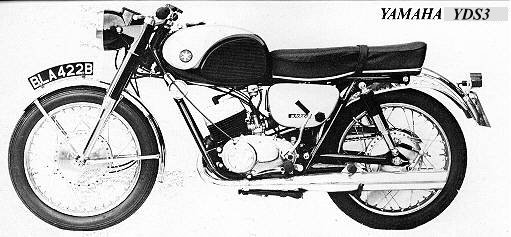
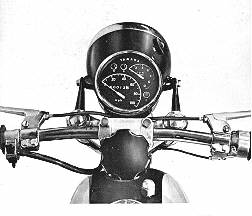
Peak power is at 7500rpm on the combined instrumentation |
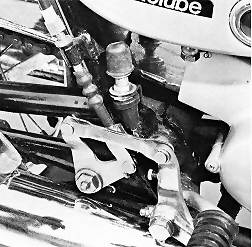
Tortuous brake geometry is pointless but mavellously engineered |
| Engine: Yamaha 246 cc (56 x 50mm) two-stroke twin. Crankshaft supported in four roller bearings; needle-roller small-end and big-end bearings. Light-alloy cylinder head; compression ratio 7.5 to 1. Independent pumped Autolube lubrication; oil-tank capacity, 3.2 pints.
Carburettors: Two Mikunis with air filter. Direct-operating, coupled air slides. Electrical Equipment: Mitsubishi 65-watt dc generator charging six-volt battery through automatic voltage regulator. Coil ignition. 6in-diameter headlamp with pre-focus light unit; 35/35-watt main bulb. Transmission: Five-speed gear-box in unit with engine. Gear ratios: bottom, 19.81; second, 13.2; third, 9.72; fourth, 7.61; top, 5.94 to 1. Helical-gear primary drive. Wet, multi-plate clutch mounted on left side of crankshaft. Rear chain % x %in with top guard. Engine rpm at 30 mph in top gear, approximately 2,500. Fuel Capacity: 3 '/a gallons. Tyres: Yokohama 3.00 x 18in; studded rear, ribbed front. Suspension: Telescopic front fork with hydraulic damping. Pivoted rear fork controlled by spring-and-hydraulic units with three-position adjustment for load. Dimensions: Wheelbase 52in. Ground clearance, 7in. Seat height, 31in. All unladen. Weight: 357 Ib as tested. Price: E279 19s, including British purchase tax. Road Tax: E2 5s a year. Concessionaires: Yamaha Motor Cycles, Camberwell Trading Estate, 117/119, Denmark Road, London, SE5. Description: Motor Cycle, 5 November 1964. Performance Data
|
| 10-30 mph
Bottom 3.8s
|
20-40 mph
Bottom N/A 2nd N/A 3rd 4.2s 4th 6.5s Top N/A |
30-50 mph
Bottom N/A 2nd N/A 3rd 5.6s 4th 8.2s Top 12.4s |
| Mean speed at end of quarter-mile from rest: 76 mph. Mean time to cover standing-start quarter mile: 16.5s.
Petrol Consumption: At 30 mph, 75 mpg; at 40 mph, 64 mpg; at 50 mph, 54 mpg; at 60 mph, 50 mpg. Braking: From 30 mph to rest, 34ft (surface, dry tarmac). Turning Circle: 15ft. Minimum Non-Snatch Speed: 18 mph in top gear. Weight per cc: 1.45 lb. |